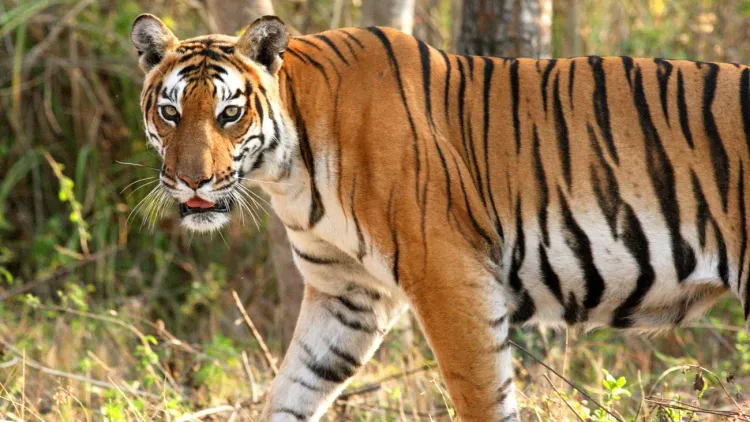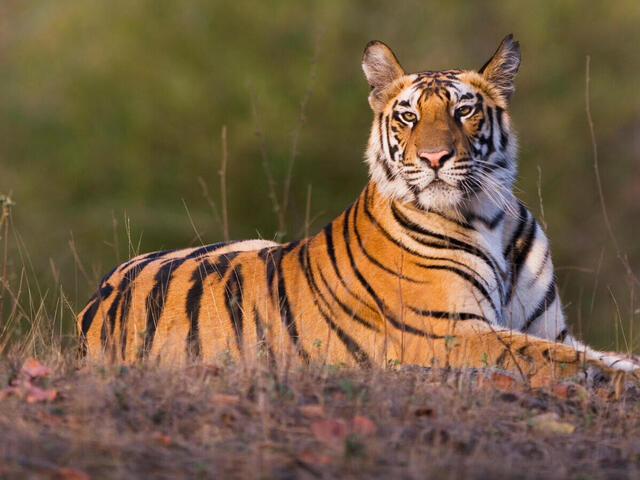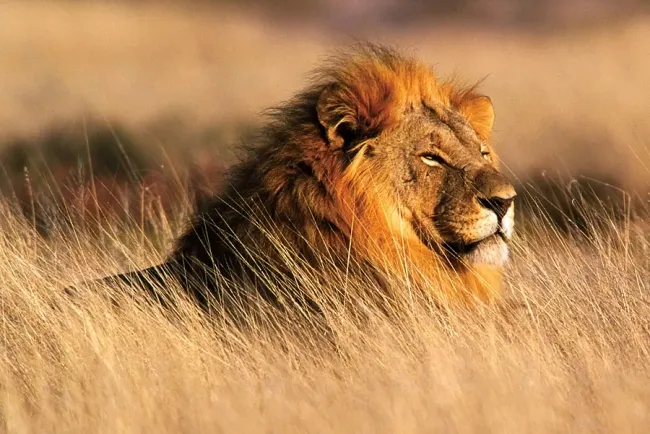Tigers: Icons of Strength and Elegance in the Animal Kingdom...!!!
Tigers are among the most iconic and majestic creatures in the animal kingdom, celebrated for their striking appearance, powerful build, and mysterious presence. As the largest members of the cat family, tigers (Panthera tigris) are apex predators that have fascinated human imagination and culture for centuries.

Physical Characteristics
Tigers are instantly recognizable by their distinctive coat of reddish-orange fur with black vertical stripes. Each tiger's stripe pattern is unique, similar to human fingerprints, allowing for individual identification in the wild. Their underbelly is typically white, and they have white markings on their face that highlight their piercing amber or green eyes.
Adult male tigers can weigh between 200 to 670 pounds (90 to 300 kilograms) and measure about 8 to 10 feet (2.5 to 3 meters) in length, including their tail. Females are generally smaller, weighing between 140 to 370 pounds (65 to 170 kilograms). Tigers possess strong, muscular bodies with powerful limbs, enabling them to easily take down large prey.
Habitat and Distribution
Historically, tigers roamed vast areas across Asia, from eastern Turkey to the Russian Far East, and from the snowy taiga to tropical forests. However, their range has significantly decreased due to habitat loss, poaching, and human-wildlife conflict. Today, wild tigers are primarily found in India, with smaller populations in Nepal, Bhutan, Bangladesh, Myanmar, Thailand, Malaysia, Indonesia, and Russia.
Tigers inhabit diverse ecosystems, including tropical rainforests, mangrove swamps, grasslands, and savannas. They require large territories to support their solitary and territorial nature, with home ranges varying based on prey availability and habitat quality.
Behavior and Social Structure
Tigers are solitary animals, with adults typically coming together only for mating. Each tiger establishes and maintains a territory marked by scent markings, scratch marks on trees, and vocalizations. Males usually have larger territories that overlap with those of several females, while females have smaller, exclusive territories where they raise their cubs.
Tigers are nocturnal hunters, relying on their acute senses of sight and hearing to locate prey. They are ambush predators, often stalking their prey silently before launching a quick and powerful attack. Their diet primarily consists of large ungulates, such as deer, wild boar, and bovines, but they can also hunt smaller animals when necessary.

Reproduction and Lifespan
The mating season for tigers varies by geographical location, but it generally occurs between November and April. After a gestation period of about 3.5 months, a female tiger gives birth to a litter of 2 to 4 cubs. The cubs are born blind and helpless, relying entirely on their mother for nourishment and protection.
The mother raises the cubs alone, teaching them essential hunting and survival skills. By the age of 2 to 3 years, the cubs become independent and leave their mother's territory to establish their own. In the wild, tigers have a lifespan of 10 to 15 years, while those in captivity can live up to 20 to 25 years.
Conservation Status and Threats
Tigers are classified as endangered by the International Union for Conservation of Nature (IUCN), with an estimated global population of around 3,900 individuals in the wild. Several subspecies of tigers, such as the Bali, Javan, and Caspian tigers, have already become extinct.
The primary threats to tiger populations include habitat destruction, poaching, and human-wildlife conflict. Deforestation and urbanization have fragmented and reduced their natural habitats, making it difficult for tigers to find sufficient prey and establish territories. Poaching for their bones, skin, and other body parts, which are highly valued in traditional medicine and the illegal wildlife trade, has further decimated their numbers.
Conservation Efforts
Efforts to conserve tigers have gained momentum in recent years, with various governments, non-governmental organizations, and international bodies working together to protect and restore tiger habitats. Key conservation strategies include:
-
Habitat Protection: Establishing and managing protected areas, wildlife corridors, and national parks to ensure safe habitats for tigers.
-
Anti-Poaching Measures: Strengthening law enforcement, patrolling, and monitoring to curb poaching and illegal wildlife trade.
-
Community Involvement: Engaging local communities in conservation efforts through education, awareness, and sustainable livelihood programs.
-
Research and Monitoring: Conducting scientific research and using technology, such as camera traps and GPS collars, to monitor tiger populations and their movements.
-
Global Cooperation: Collaborating across borders to implement conservation policies and share best practices.
In conclusion, tigers are magnificent creatures that play a vital role in maintaining the ecological balance of their habitats. While they face significant threats, concerted conservation efforts offer hope for their survival and the preservation of the rich biodiversity of our planet. By continuing to protect and restore their natural habitats, we can ensure that future generations can witness the awe-inspiring presence of tigers in the wild.
What's Your Reaction?
















